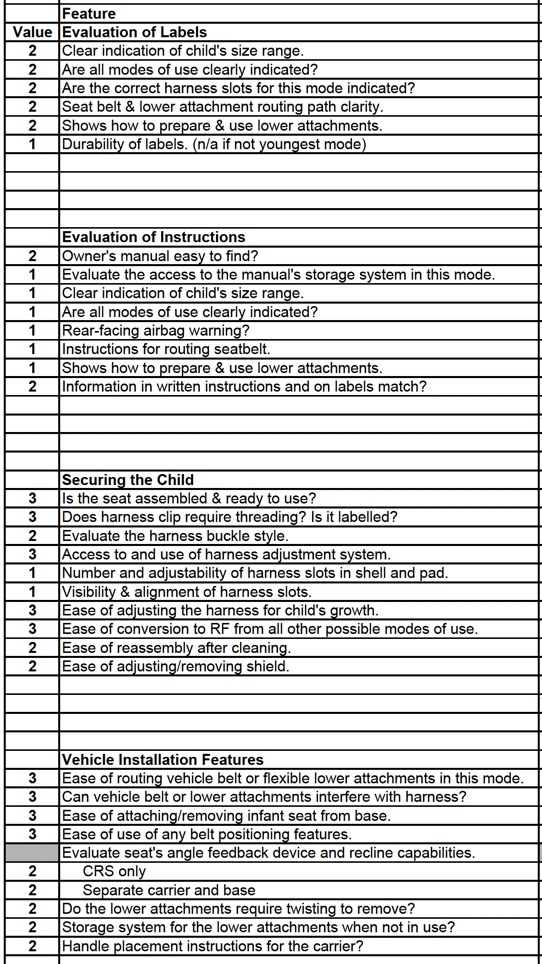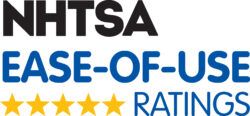Besides regulating vehicles and CRs through Federal Motor Vehicle Safety Standards, NHTSA also influences roadway safety through its various ratings programs, which can be found here.
For vehicles, the agency’s New Car Assessment Program (NCAP) is considered a safety rating because it has a crash test component in addition to promoting the presence of certain desired (but not required) safety features.
NHTSA’s Car Seat Ease-of-Use (EOU) rating, on the other hand, is not considered a safety rating because it focuses on how easy a product is to use (with no dynamic testing component). For each mode of use for each CR or booster evaluated, NHTSA rates four characteristics for ease of use (labels, instructions, securement, and installation) and assigns an overall rating. Since 2008, these ratings have been presented using a five-star scale, aligning with NCAP ratings.
Although not technically a safety rating, the CR/booster EOU ratings certainly do promote safety because a product that’s easier to use is less likely to be misused. Since all CRs must meet a minimum performance standard when used properly, eliminating misuse is a vital step toward maximizing a CR’s safety benefits. Therefore, pointing caregivers to easier to use (and harder to misuse) CRs is NHTSA’s primary reason for publishing EOU ratings.
The ratings program also influences safety by nudging manufacturers to voluntarily make improvements to earn a higher score. For conscientious manufacturers, the publicly available EOU scoring rubric provides a roadmap, of sorts, when designing CRs.
Study Examines How Well EOU Ratings Correlate with Misuse in the Field
While the objective of NHTSA’s CR/booster ratings is to guide families and the industry to safer CRs, the ability of the ratings to promote safety in practice hinges on how accurately the scoring rubric identifies and weighs the features that truly matter for safety.
Recently, a group of researchers (Macy et al.) conducted a secondary analysis of data to determine how effective the EOU ratings are at doing that. The researchers examined Safe Kids Illinois seat check records and compared the misuse findings with the corresponding NHTSA EOU ratings for each CR or booster model.
The Illinois data was from CR checks documented using the longstanding standardized Safe Kids Worldwide (SKW) checklist form, which gathers data on type of CR, brand, model number, and five installation and use errors (recline angle, harness, lower anchors, tether, and seat belt). SKW provided the researchers with a spreadsheet of data from the paperwork that CPS teams in Illinois sent in from 2015 through 2019 to be digitally scanned.
After cleaning the data (for instance, removing records that lacked model numbers, were for adaptive CRs, etc.), 2,616 car seat checks were available to compare to NHTSA’s EOU ratings from 2008 to 2020. Among CRs mentioned in the Illinois checkup forms, there were 217 exact matches to models in the EOU ratings and 244 probable matches (in which the model number matched except for a few digits, likely denoting the CR’s fabric). In addition, 1,671 models were deemed near matches after retrieving CR model names by doing a web search of model numbers. In total, researchers were able to compare 1,929 CR check findings to EOU ratings, 72% of which were for CRs used rear facing.
EOU Study Findings
Overall, the study found a pattern of fewer observed errors among CRs with higher EOU ratings. This is a positive general finding, suggesting that NHTSA’s EOU ratings, using the current rubric (see image, below), are predictive of real-life errors in installation and harness use and can steer families to models they are more likely to use properly.
However, the study report also notes that, even among the CRs rated most highly for EOU (earning five stars), a considerable amount of misuse occurs, suggesting that far more needs to be done to ensure all CRs are used properly. The misuse rate among the Illinois checkup forms was consistent with earlier studies of CR misuse, with the most common types of misuse having to do with using a seat belt for installation and using a tether (or not using one when directed to, whether using a seat belt or LA attachment for installation).
In fact, tether misuse was observed about 50% of the time, which is consistent with other studies showing low tether use and high misuse rates (McKay et al., 2017; IIHS/UMTRI, 2012). It is especially telling that the rate of misuse/nonuse was consistent despite a model’s star rating; a highly rated CR was just as likely to have a misused or unused tether as a CR with a lower rating. The scoring rubric does not evaluate tether instructions or use, so an important consideration for NHTSA would be to find ways to encourage tether use in future updates to the rubric.
Although installation misuse was observed more frequently for seat belt installations than for lower anchor attachments, SRN wonders whether the comparative proper use of LA attachments observed could be skewed by the fact that most CRs brought to checkups are used rear facing. Because the data reflects more rear-facing than forward-facing CRs, certain LA attachment misuse that more often occurs when using CRs forward facing, such as exceeding a weight limit or misrouting an LA strap (from the typical out-of-box RF belt path), is likely to be underreported in the data. Since the EOU scoring rubric evaluates the ease of routing the LA strap and whether the belt can interfere with the harness, the EOU ratings may currently be helping guide caregivers of older children in ways that are not fully captured by data from checkup events.
A stated limitation of this study (and so many others) is that it only includes checkup findings for CRs owned by caregivers who sought help from CPSTs. As the authors note, whether that population is more or less likely to make errors than the average caregiver is unknown (and a good research question for future study). In addition, using the Safe Kids checkup forms limited the research to only the five general areas of misuse, so further study using more detailed data from the National Digital Car Seat Checkup Form could be more enlightening.
Takeaways for CPSTs
The study report notes that, besides encouraging caregivers to use the NHTSA EOU ratings, CPSTs could also use the ratings to learn which CR features are most prone to errors. For any given checkup, CPSTs could emphasize the proper use of those features that the ratings program awards a lower score and are more likely to be misused.
There are a number of ways to access the EOU ratings. For instance, selecting Car Seats at www.nhtsa.gov/ratings presents two options. Clicking on NHTSA’s Car Seat Finder tool and entering a child’s age, height, and weight generates a link to the EOU ratings for each CR model the tool recommends. In addition, the CR ratings page also links to a list of rated CRs sorted by brand.
While these formats are useful when shopping for a CR or looking for information for one child, CPSTs will likely find NHTSA’s detailed information about all ratings to be more useful. That information is posted in NHTSA’s general docket (search NHTSA-2006-25344). The docket contains EOU documents by year (some years having more than one submission) and other documentation that supports the program. (Note: Not all CRs on the market for a given year get rated.)
Searching the docket for this documentation yields a far greater amount of detail. While only star ratings are available on the NHTSA site, the docket’s documents state the results of each model’s complete scoring rubric (template shown below). For instance, on the NHTSA site, one CR model rates two stars for harness use; by looking up the details for this model at www.regulations.gov, one learns that the most significant reasons the model was down-rated in this category are that it must be assembled for use (and is difficult to reassemble after cleaning) and is relatively hard to adjust for growth or to change modes. These score details could signal a CPST assisting a caregiver who owns this model to focus extra education on these tricky aspects of the CR.
Of course, since not every CR is rated and not every topic is covered (like tethering, as mentioned earlier), NHTSA’s EOU ratings should not be the only method that families and CPSTs use to assess CR models. But, as a resource that research has found to be a reasonable predictor of actual use, the EOU ratings program is a tool that CPSTs can add to their toolkit to enhance their ability to educate caregivers.

How NHTSA Determines a CR’s Star Ratings
To the left is the rubric NHTSA uses to assign star ratings to four key aspects of each evaluated CR model (labels, instructions, securing the child, and installation). Each mode of use is rated separately.
The score for each sub-category is multiplied by the number in the “value” column to give it proportional weight reflecting how critical NHTSA deems the characteristic to be as a component of each category.
A compilation of all category scores determines a CR’s overall score. The category scores and the overall score are rounded up to the nearest whole number and given a corresponding star designation that is posted on the NHTSA website.
Readers interested in seeing the scores sheet for each CR model, which provides more detail than is available on the NHTSA website, can search NHTSA-2006-25344 at www.regulations.gov.
Reference:
Macy, ML; Lee, JY; Kendi, S; Zonfrillo, MR; Hill, A. “Ease of Use ratings and real-world child restraint system errors from Safe Kids Illinois seat checks, 2015–2019.” Traffic Inj Prev. July 21, 2023. doi: 10.1080/15389588.2023.2233647. Epub ahead of print. PMID: 37477419.

